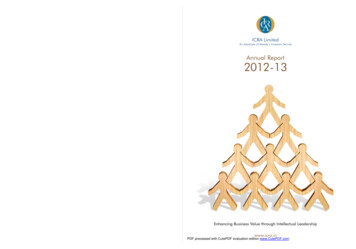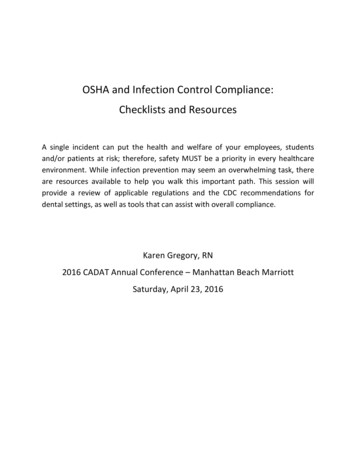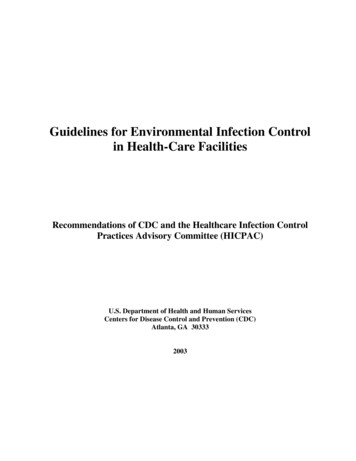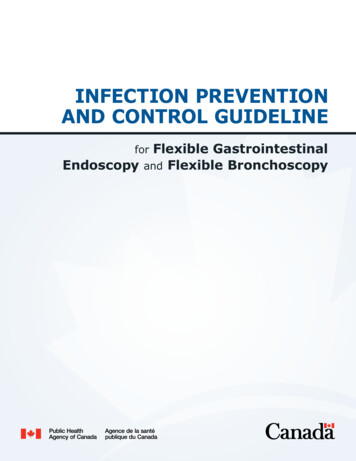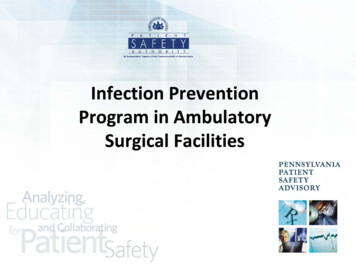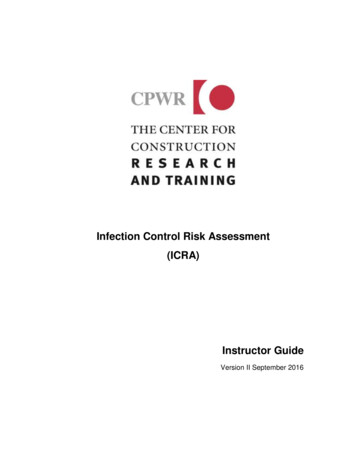
Transcription
Infection Control Risk Assessment(ICRA)Instructor GuideVersion II September 2016
TABLE OF CONTENTSBackground . 4General Information . 4Purpose of the instructor guide .4Teaching Materials .4Suggestion for time management .4Preparing for Class . 5Lesson Plan . 6Welcome! . 6Goal of the ICRA Awareness Course . 6Learning Objectives . 7What is ICRA?. 8Where is ICRA Used? . 9Hospital Construction is different . 10Rules regarding how construction workers behave. . 11There are special hospital rules to comply with. . 12Your job requires a level of confidentiality. . 13There are specific hospital alarms you need to be aware of. . 13Working in a health care facility carries with it certain risks. . 14Hospitals hazards that are not on typical construction sites. 15Hospitals are concerned about hospital-acquired infections. 16Understanding the chain of infection can help with the prevention of infectiousdiseases. . 17A pathogen is a substance that causes a disease. . 17Serious infection or death can occur when mold spores are inhaled or enter thebloodstream. . 18Bacteria can cause diseases in people with weakened immune systems. . 18Viruses are a type of pathogen. . 19A pathogen is a substance that causes a disease. . 19Aspergillus is common in the environment. . 20Aspergillus fungus can cause an infection called aspergillosis. 21Legionella is a bacterium that can cause Legionnaires’ disease. . 21Legionella can be found throughout healthcare facilities. . 22The reservoir is the environment in which the pathogen is found. . 23Portal of exit means how the pathogen is released into the ambient air. . 24Pathogens are spread by three routes that are a concern for infection control. 24The Portal of Entry is the opening that allows the pathogen to enter the host. . 25Immunocompromised patients are most at risk during construction activities.25Examples of patients who are immune compromised. . 26ICRA is a planning tool to minimize hospital-acquired infections. . 30The ICRA process does a lot of things beyond identifying risks. . 31The ICRA plan will include a detailed list of precautions that must be followed.31Hospitals follow three steps in formulating the ICRA. . 32ICRA employs three principles to control the spread of infections. . 322
Preventing dust minimizes patient exposures. . 36The primary function of a barrier is to control the air quality in occupied areas.36Mobile containment cubes are used for inspection and short-term cavity work.37To enclose a larger work area a soft wall barrier system can be used. 38An entry must be created to access the work area. . 38When a longer-term barrier is needed a hard wall barrier or rigid wall is used.39Anterooms separate work area from the patient occupied area of the hospital.40An anteroom is as a changing room to put on Patient Protective Apparel. . 40Personal protective apparel is worn to prevent the spread of construction dust.41Removing PPA properly is important so dust is not spread. . 42Typical procedure to follow when entering and exiting through an anteroom: 42Hand washing and proper cleaning of clothing are important. . 43Controlling the air pressure can prevent the spread of dust. . 45A HEPA negative air machine is used to pull air from the work area. . 45How to ensure negative air pressure is being maintained. . 46Good housekeeping is essential to minimizing the spread of dust. 47Sticky mats/walk off mats are used to remove dust. . 48Trash/debris removal requires special handling. . 48The movement of equipment, tools and materials requires special handling. . 49Hospitals contain hazards that could affect a worker’s health and safety. . 49Exposure to bloodborne pathogens are a common biohazard to workers. . 50Lead and asbestos hazards may also affect workers in hospitals. . 51It is not uncommon to find mold during hospital construction work. . 51Medical equipment in a hospital can be dangerous for construction workers. . 52Pay attention to your surrounding inside the hospital. . 53Hospitals expose you to unique hazards not encountered on a typical jobsite. 53ILSM are put in place to protect the safety of patients, visitors, and staff whowork in the hospital. 543
BACKGROUNDConstruction work in a healthcare facility such as a hospital, or other occupiedfacilities such as office buildings and schools may require special procedures,equipment and precautions for performing the work. Construction, renovation anddemolition activities can affect hospital patients, visitors and can even cause newinfections. Dust from construction, renovation and demolition activities can be ahazard for patients, healthcare workers, and visitors. Dust is especially a risk forpatients with compromised immune systems.To help prevent further injury from construction dust, hospitals use a systemcalled Infection Control Risk Assessment (ICRA) to decide how to protect theirpatients, staff, and visitors during a construction project. The ICRA will determinethe level of barriers, dust control, cleaning, and patient protective apparel youmust use during your construction project. You may have to build barriers,maintain negative air pressure inside your work area, or use special air filteringequipment. You may have to put up a temporary plastic sheeting barrier whileyou build a long-term rigid barrier behind it. The ICRA may require you to spendmore time putting up barriers to isolate your work area than it takes to actuallyperform the work.GENERAL INFORMATIONPurpose of the instructor guideThis guide is designed to provide instructors/trainers with the information needed tosuccessfully conduct the Infection Control Risk Assessment (ICRA) Awareness training.Teaching Materials Instructor Guide - Includes:o Thumbnails and numbers of corresponding PowerPoint slideso Notes for each slidePowerPoint slides - Include:o Notes for each slideParticipant ManualHandoutsSuggestion for time managementIt takes approximately 6- 8 hours to complete the ICRA Awareness training. Theschedule has flexibility built into it to allow for site specific information to be included.Site specific information may include PowerPoints and written materials provided by theemployer of the hospital administration.4
Preparing for ClassClassroomSet up an LCD projector and computer. Click through the PowerPoint to ensureequipment is working properly.Each participant should have an application, participant manual, course evaluation, notepad and pen. Ask participants to fill out the application form. Explain the evaluation formis being distributed to them at the beginning of the course so they can write down theircomments and suggestions as the class is being conducted.Distribute a pre-test to each participant and tell them this is designed to help youunderstand the level of experience and knowledge within the class. This pre-test will notbe graded or used to determine if a participant passes the course. The pre-test shouldnot take more than 10 minutes to complete. Collect the pre-tests and determine whatinformation participants already know and what they don’t know. Discard the pre-testswhen you are done reviewing them.Hands-onSet up the mobile containment cube to make sure all parts are available and working.Disassemble the containment cube and place out of the way of the classroom. Theparticipants will construct the containment cube as part of their hands-on activities.Collect samples of other materials used on ICRA construction projects; sticky mats,patient protective apparel and soft-wall barrier components (If available). Place the itemsin the classroom for demonstration/show and tell.5
Lesson Plan(TIME 6.0 – 8.0 hours)Welcome!NOTES FOR SLIDE 2Introductions: NameTradeYears in constructionGoal of the ICRA Awareness CourseNOTES FOR SLIDE 3The ICRA awareness courseprovides the necessary training tounderstand the Infection ControlRisk Assessment (ICRA) proceduresfor properly performing healthcare orother occupied facility constructionand renovation tasks. In addition,participants will examine thepractical use of ICRA tools including containment, negative air, HEPA filtration,and work practice techniques. The course uses a variety of adult educationclassroom activities to build upon the experiences participants have working inconstruction, renovation, demolition, or healthcare facility environments.ASK CLASS:How many of you have heard of ICRA before today?Has anyone worked in a hospital environment?Where did you work and what type of work were you doing?After a little discussion, let them know you’ll be discussing the concepts ofICRA throughout this course.Or6
If no one has any experiences to talk about, let them know you’ll bediscussing the concepts of ICRA throughout this course.Learning ObjectivesNOTES FOR SLIDES 4-6We expect that by the end of today’straining each of you will be able to: Define ICRA and explain why itis used.Describe how healthcareconstruction worksites differfrom regular constructionworksites.Explain the importance offollowing work place rules andusing designated areas forbreaks, as defined by theICRA.Define Hospital AcquiredInfections (HAI) and describethe Chain of Infection.Identify common pathogensfound in a healthcare settingand describe how they aretransmitted.Identify unique hazards specificto healthcare construction,including hospital utilitysystems and medical gaslines, and methods to avoidthem.Describe the steps used in thecreation of an Infection ControlRisk Assessment Plan.Specify the specific infectioncontrol precautions used forthe four classes of ICRA construction.Identify different types of barriers used and guidelines for choosing them.Describe the procedure for entering/exiting through an anteroom.List the two main functions of a negative air machine in an ICRA workenvironment.7
Describe appropriate methods for transporting trash, tools and materialsfrom the workspace.Identify potential hazards to workers in a healthcare setting.Define life safety system and explain the use of Interim Life SafetyMeasures in a healthcare worksite.What is ICRA?NOTES FOR SLIDE 7Only show the title of thePowerPoint slide “What is ICRA?”To get us started, I’d like us to talkabout:ASK THE CLASS:“What is ICRA?” Can anyone tell me what ICRA is?On a white board or flipchart write down the various descriptions given bythe participants.Once everyone is done giving a description, advance the PowerPoint toshow the definition from the participant manual.ADDITIONAL INSTRUCTOR NOTESIf students can’t come up with ideas, ask a few of these questions. What is the primary responsibility of a hospital? (Make people better.) What is it about construction that can cause infections to be spread in ahospital? (Uncontrolled construction dust can spread infections to clean partsof a hospital.) How can constructions workers, working in a hospital, help controlinfections? (Follow the rules established to prevent the spread of infectionswithin the hospital.)8
Where is ICRA Used?NOTES FOR SLIDE 8Only show the title of thePowerPoint slide “Where is ICRAused?”From our previous discussion weidentified that ICRA is used toprevent the spread of infections inhealthcare facilities. Now that we know what ICRA is, let’s discuss where ICRAcan be used.ASK THE CLASS:What are some examples of healthcare facilities where ICRA might be used?Write the participant responses on a whiteboard or flipchart.Once everyone is done giving examples, advance the PowerPoint to showthe examples from the participant manual.ASK THE CLASS:Can you think of other types of facilities where controlling dust to protect theoccupants or the processes happening within the building might be importantduring construction, renovation or demolition?Write the participant responses on a whiteboard or flipchart.ADDITIONAL INSTRUCTOR NOTESIf students can only provide a few (or no examples) highlight the last 4examples on the slide. Ask them what these facilities have in common.(People occupy them and exposure to dust and the air quality of the space is aconcern.)Additional examples include: Factories, food processing plants, electronicsmanufacturing.9
Hospital Construction is differentNOTES FOR SLIDE 9Today’s healthcare constructionmarket consists of both newconstruction and renovation. Whenwe think of hospital construction, weare also talking about renovation anddemolition. During the course, whenwe say “hospital construction” wereally are discussing any one ofthese construction activities.ASK THE CLASS:What’s the difference between doing hospital construction and regularconstruction?Write the participant responses on a whiteboard or flipchart.ADDITIONAL INSTRUCTOR NOTESIn case participants cannot think of any differences, below are some examplesyou can use to get them thinking:1. Hospitals cannot shut down for construction. They have to operate 24hours a day, seven days a week.2. Nurses, doctors, and other hospital staff may be working around you.3. Patients may be close to your activities.4. The pace on a normal construction project is typically fast paced with thegoal of finishing the project as fast as possible.10
Rules regarding how construction workers behave.NOTES FOR SLIDES 10 and11Only show the title of thePowerPoint slide “Rulesregarding how constructionworkers behave.”Working on a hospital project hasdifferent rules than normalconstruction. Because you areworking around staff, patients andvisitor, our behavior has to berespectful. Remember, being in ahospital is already stressful so we donot want to add to the stress level.Divide the participants into 3 or 4groups. Tell them to designateone person to write down the group’s responses on a piece of flip chartpaper.ASK THE CLASS:What behaviors do you think construction workers need to follow when working ina hospital?Tell the groups they have about 5 minutes to write down as many ideas they cancome up with. Remind them to write their list on the flip chart.Check in after 5 minutes. If they groups are done proceed to the next step. If thegroups are still working, give them 1 more minute.Go around the room and ask each group to read one item from their list.On a white board or flipchart write down the various descriptions given bythe participants.Review the information on slides 10 and 11 to fill in any gaps the list mighthave.11
There are special hospital rules to comply with.NOTES FOR SLIDE 12Along with specific behaviors tofollow, hospitals may also havespecial rules construction workersneed to follow. These rules are putinto place to minimize the disruptionconstruction workers can have onthe hospital staff, patients andvisitors.Keeping the participants in the same groups:ASK THE CLASS:What specific rules do you think construction workers need to follow whenworking in a hospital?Tell the groups they have about 5 minutes to write down as many ideasthey can come up with. Remind them to write their list on the flip chart.Check in after 5 minutes. If they groups are done proceed to the next step. If thegroups are still working, give them 1 more minute.Go around the room and ask each group to read one item from their list.On a white board or flipchart write down the various descriptions given bythe participants.Review the information on slide 12 to fill in any gaps the list might have. Only park in designated areas – parking may be limited and the hospitalwill want its staff, patients and visitors to have the best spots.Requirements to wear ID badges – security is important and the hospitalwill want to make sure authorized workers are easily identifiable.Specific paths through the building for workers, materials, and debris – tominimize interactions with patients and visitors, you may be restricted tocertain hallways, elevators, etc.Emergency exit routes – you will need to become familiar with theemergency exits.The restrooms you can use – the hospital may not allow you to usespecific bathrooms. They may require you to use specific ones only.12
Whether you can use public vending machines – these may be reservedfor hospital staff, patients and visitors only. The hospital may try to limit theamount of exposure patients and visitors have with the construction folks.Whether you can use their public cafeteria – this again is a way to limit theamount of interaction between you and the hospital.Break area locations – the hospital may specify where you can takebreaks. They may set aside a separate break room for the workers.Your job requires a level of confidentiality.NOTES FOR SLIDE 13Working around file cabinets orcomputer workstations that containpatients’ medical records creates alegal hazard under HIPAA. HIPAAstands for the Health InsurancePortability and Accountability Act of1996, a federal law which requireshealthcare providers to maintain thesecurity and confidentiality of patients’ health information. Do not touch or look at medical files! Do not share anything you see or hear at a hospital! You may have to sign the hospital’s internal HIPAA confidentiality policy.Contact the hospital staff if you see medical records in your work area. Youand/or your employer could be sued if you are involved in a privacy violation.There are specific hospital alarms you need to be awareof.NOTES FOR SLIDE 14Only show the title of thePowerPoint slide “There arespecific hospital alarms you needto be aware of.”Explain to the class that they need tobecome familiar with the hospitalemergency codes.13
Click on the PowerPoint one more time so the following questions appear:What does “Code Blue” mean?What does “Code Red” mean?What does “Code Green” mean?Ask the classWould anyone like to answer the first question?Once they answer it, click on the PowerPoint. Repeat this for the next 2questions until all 3 questions have been answered.Click on the PowerPoint once, “Site Specific Codes” appears.Explain that hospitals may have different codes. These will be explained in afacility briefing when you start working on the job. You need to know what thesecodes mean, and what to do when an alarm is announced. Some codes won’taffect you, but some might require you to evacuate the building.Working in a health care facility carries with it certainrisks.NOTES FOR SLIDE 15Before working in a health caresetting, all of your immunizationsshould be current. To avoid gettingthe hospital patients sick, it is veryimportant not to come to work sick.Additionally, your supervisor shouldbe notified if anyone on your crewbecomes sick while working at ahealth care facility.The following are examples of immunizations workers should consider whenworking within an ICRA environment: Influenza vaccination (flu shot)Tetanus, diphtheria, and acellular pertussis (Td/Tdap) vaccinationVaricella vaccination (Chickenpox)Measles, mumps, rubella (MMR) vaccinationHepatitis B vaccinationSomething as simple as catching a cold at work may be an indication theprecautions are not working. Any illness or infection contracted at the facility14
should be reported to the infection control department so they can take whateversteps necessary to trace, track and contain any potential outbreaks.Examples of immune compromising conditions are: Hepatitischronic pneumoniaHIVasbestosisHospitals hazards that are not on typical constructionsites.NOTES FOR SLIDE 16Only show the title of thePowerPoint slide “Hospitalshazards that are not on typicalconstruction sites.”ASK THE CLASS:Think about the various utilities andmedical devices in a hospital room, are there any unique hazards in these roomsthat are not found on typical construction hazards?Write the participant responses on a whiteboard or flipchart.Review the information on slide 16 to fill in any gaps the list might have.Mechanical, Electrical and Plumbing systems are critical, and can’t beinterrupted.Medical Gas Lines - Medical gas lines are an extra utility to be concerned with inhospitals. You may encounter color-coded outlets, and lines inside the walls. OxygenNitrogenNitrous oxideCarbon dioxideLow-pressure “medical air”High-pressure “instrument air”Negative-pressure vacuum15
Glass Pipes - The glass is very resistant to chemicals and won’t corrode, so it istypically used for waste lines in hospitals and laboratories. You should assumethat these lines contain hazardous chemicals or biohazards.Once the class has reviewed the hazards found in a hospital room askthem if there are any unique hazards outside of the hospital that we need tobe aware of.Helipads - Many hospitals have helipads, landing areas for ambulancehelicopters. If your construction project involves a crane or excavator, it mustlower its boom when a helicopter is operating nearby, as well as at the end of theshift. Workers using aerial lifts near helipads must also watch for approachinghelicopters, the downwash could cause the lift to overturn.Hospitals are concerned about hospital-acquiredinfections.NOTES FOR SLIDE 17Hospital-acquired infections or HAI,is when a patient acquires, or gets,an infection inside the hospital.ASK THE CLASS:Does anyone have an example of ahospital acquired infection thathappened to them or someone theyknow?Limit the number of stories to one or two in the interest of time.Hospital-acquired infections are a huge problem. HAIs occur in all settings ofcare, including hospitals, surgical centers, ambulatory clinics, and long-term carefacilities such as nursing homes and rehabilitation facilities.According to a study published online September 2, 2013 in JAMA InternalMedicine, HAIs are costing healthcare facilities almost 10 billion a year.According to the Centers for Disease Control (CDC), about 1.7 million hospitalacquired infections occur each year and more importantly, about 99,000 hospitalpatients die from HAIs each year.16
Understanding the chain of infection can help with theprevention of infectious diseases.NOTES FOR SLIDE 18The spread of an Infectious diseaseresults from the interaction of apathogen, a host (patient), and anenvironment. Most of these diseasesfollow a typical chain of infection thatends with an infected patient.The chain of infection is made up ofsix different links: pathogen, reservoir, portal of exit, means of transmission,portal of entry, and the new host. Each link has a unique role in the chain andeach can be interrupted, or ‘broken’, through various means.ICRA is designed to break the infection chain in multiple places to ensureinfections do not spread as a result of our construction activities.The Chain of Infection is principle used in epidemiology to described infectiousdiseases. sson1/section10.htmlThe next series of slides will address each link of the chain.A pathogen is a substance that causes a disease.NOTES FOR SLIDE 19Before starting the PowerPointpresentation, distribute handouts1 through 6.Instruct the participants to answerthe questions on the handouts asyou go through the information onthe next 15 slides.FYI: The plural of fungus is fungi, and the plural of bacterium is bacteria.A pathogen is a substance that causes a disease, especially a livingmicroorganism such as a fungus or bacterium. Typically the term is used todescribe an infectious agent such as a bacterium, fungus, virus, or parasite thatcauses disease in its host.17
Yeasts, molds, and mushrooms are all types of fungi. Some fungi are useful—weuse yeast to make bread and beer, penicillium mold to make antibiotic drugs andblue cheese, and we eat many kinds of mushrooms.This training will only discuss bacteria, fungi and viruses because these are themost common pathogens associated with ICRA.Serious infection or death can occur when mold sporesare inhaled or enter the bloodstream.NOTES FOR SLIDE 20Serious infection or death can occurwhen mold spores are inhaled orenter the bloodstream. Mold releasesspores that can become airbornewhen disturbed by activities such ashousekeeping, renovation,maintenance and construction workand even from air flow! These sporesare easily inhaled and can cause health problems in people who come in contactwith them.Bacteria can cause diseases in people with weakenedimmune systems.NOTES FOR SLIDE 21Bacteria are single-cell organismsthat can also be helpful or harmful.We all have many different speciesof beneficial bacteria living in ourintestines, which help us digest food.But other types of bacteria can makeyou sick. They can be resistant toantibiotics and can be easily transmitted through the air, on contaminatedsurfaces and from person to person.Exposure to bacteria can result from any type of contact, including breathing,touching or ingesting. Most bacteria are opportunistic organisms meaning theycan cause diseases in people with weakened immune systems.18
Viruses are a type of pathogen.NOTES FOR SLIDE 22A virus is a small infectious agentthat replicates only inside the livingcells of their hosts. They can causeminor illnesses like the commoncold, but some cause life-threateninginfections, such as liver infectionsfrom hepatitis B.Viruses spread in many ways; By coughing and sneezing.By the fecal–oral route. Hygiene and handwashing can act as effectivebarriers to stop the transmission of diseases via fecal-oral pathways.Are passed from person to person by contact, or by entering the body infood or water.A pathogen is a substance that causes a disease.NOTES FOR SLIDE 23Common pathogens that are ofconcern in hospitals especially whendisturbed by construction activitiesare: Aspergillus - The most commoncause of construction-relatedhospital-acquired infections. Legionella - is a bacterium that can cause Legionnaires’ disease, orlegionellosis19
Aspergillus is common in the environment.NOTES FOR SLIDE 24Aspergillus is in soil, on plants, andin decomposing plant matter. It isalso in the dust inside buildings,such as the dust on top ofsuspended ceiling tiles. Most peoplebreathe in aspergillus spores everyday without getting sick. However,people with weakened immunesystems or lung diseases are at a higher risk of developing health problems dueto aspergillus.Common sources (non-construction) of aspergillus in a hospital are: Ventilation systems Cleaning activities – especially concerning is the use of non-HEPAvacuums. Waste containers Potted plants Water systems - Water can contain fungi, and water systems may becomecolonized. Aspergillus species have been recovered from water taps,patient showers, and ice making machines. Aspergillus can be found growing on damp walls, as a major componentof mildew.Construction dust can spread infection because of fungi spores sticking to thedust particles. Fungi spores are like the seeds of plants, except they are smallerand usually just single-celled. But unlike seeds, fungi spores aren
found in a healthcare setting and describe how they are transmitted. Identify unique hazards specific to healthcare construction, including hospital utility systems and medical gas lines, and methods to avoid them. Describe the steps used in the creation of an Infection Control Risk Assessment Plan. Specify the specific infection
